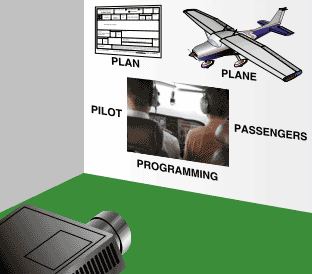 |
Risk Management (for CFI's PTS based on FOI)
5 Critical Variables, 5つの重大な要因

5P Checklistは「事前に確認すべき5つの項目が有り、それらを確認してより賢明な行動で危険を減らす」との考えです。 操縦士は5つの「P」を確認すべきなのですが、この内容は環境や状況によって大きく変化します。 ここでは、各Pに関しての項目を見て見ます。
FAAテキストには5Pの各項目に対して想定できる事、事例や最近の動向が書かれ、例には詳細まで書いています。しかし全てのフライトに共通しているかは別です。明確で単純なリストは無く、飛行に合わせて変化させる必要があります。(この場合ではPlanの部分かな。) テキストを読む時は各Pで「何をどうやって考えるべきか?」と考えながら読んでください。そして飛行中は5つの「P」を確認する時には、これらを例にして最良の手段を取って下さい。
各フライトや各セグメントでは何が5Pになるのか? 各Pで可能性が有るのは事柄は何か?と考え出せる様になってください。飛行する時は事前に各Pでは何か必要かとパイロット自身が考えるのが良いでしょう。 5P Checkはフライト前もあれば飛行中の節目でも確認します。必要なのは、重要な時点で、これら5Pの要因を再確認して、続行するか変更するかと考える事です。テキストに書かれているのは一例や忘れやすい事の説明だと思って下さい。
The Plan:
- Mission or Task ミッションやタスクと表現される時もある。
- C-X Planning, Weather, Route, Fuel, Publication Currency, etc
クロスカントリーの計画、気象、ルート、チャートの有効性など
- Review and Updated several times in flights. 飛行中は何度も見直して、修正を加える。
- Delayed Takeoffs, Weather Change, TFR, and other can radically alter the plan
離陸の遅れ、気象の変化、TFR(飛行制限)はプランを大きく変えます。
- Updated and modified and responsive to the other 4 Ps.
他の4つのPにも大きく影響されます。
- Subject to change ANY TIME. 何時でも修正が入って当然。
The Plan and Weather
- Weather is a huge part of any plan. 気象はプランに大きく影響を与えます。
- Datalink is advantage, but only if pilots are trained to retrieve and evaluate in real time without sacrificing situational awareness.
データリンクは凄いけど、パイロットが混乱しない事が前提。
- Weather information should drive a decision even to continue on the current plan.
計画を変えないとするのも、気象情報が判断の元になる。
The Plane:
- the Plane itself. 航空機自体
- database currency, automation statues, emergency backup system.
データベースの有効期限、自動操縦装置など自動化、緊急時の装置や代替
- IFR (or long flight) with or without an autopilot.
オートパイロット無しでの計器飛行や長時間のフライト。
- Low IFR with not-autopilot depend on other P's.
オートパイロットが無い機体で行うLow IFR(低高度での計器飛行)は他のPの影響を受ける。
- Pilot proficiency, currency, and fatigue.
パイロットの技量、近日中の経験、疲労度 (パイロットの能力もPlane、機材に影響する)
The Pilot:
- The traditional "I'm Safe" checklist is a good start.
昔からあるI'm Safe チェックリストは賢明なスタート。
- Flying for business can expose high altitude, long distance and endurance and challenging weather.
仕事でフライトするのは、高高度、長距離、長時間、厳しい気象状態にさらされる。
- An advanced avionic can expose more stress.
最新の装置がストレスになる場合もある
- Fatigue, sustained flight above 5,000 feet, less discerning, less critical of information, less decisive, and more compliant and accepting.
疲労、高度5,000 feet以上のフライトは
- Less Discerning 識別や認識する事が弱くなる
- Less Critical 批判的な判断が弱くなる
- Less Decisive 判断、決断力が鈍る
- More Compliant and Accepting リスクを容易に受け止めたり認めたりする。
- Pilots guard is down after long flight, fatigued. 長時間のフライトでガードが下る
- The 5 P's helps a pilot's physiological situation. 5Pは心理的な状態を助けてくれる
- If risks are identified, the pilot is in better place to make alternate plans and lessen the effect of these factors and provide a safer solution.
もしリスクを認識できれば、パイロットは代替プランへの切替えが容易になり、様々な要因の悪影響を減らし、より安全な解決策を導き出せる。
The Passengers:
- The desire of the passengers easily enters pilot decision making.
乗客の要望はパイロットの判断工程に入り込みやすい。(特に小型機)
- If done in healthy and open way, this can be positive factor.
健全でオープンな方法は、良い要因いなりえる。
- If the passenger is pilot, designate PIC and make avoid any conflict.
横にパイロット資格者を乗せる場合、PICを明確にして、緊急時の混乱を防ぐ。
- Non-pilot passenger may not understand risks.
一般人の乗客にはリスクの理解が出来無いかも。
- In SRM, make passengers involved, then they can feel some risk and undertand.
SRMを活用する場合は、乗客も取り込む事でリスクを感じ、理解が増すかも。
- Give them a task or duty to keep them involved.
タスク(用事)や任務を与え、協力を続けさす。(これでリスクに対しての注意力が増す。
- The discussion helps pilot to find out what passengers wants to do, not what you want. This removes self-induced pressure from a pilot.
乗客とは色々と話をして、何を求めているのか、何が不要なのかを聞き出す。 これによって、パイロット自身が不必要なプレッシャーを感じる必要が無くなる。
The Programming:
- Advanced Avionics = new dimension to GA Aircraft
最新のエビオニックスはGA機に新しい面をもたらした。
- Reduce pilot workload and increase pilot situational awareness.
パイロットの仕事を減らし、状況判断能力を増す。
- They tend to capture the pilot's attention too long.
パイロットの注意が集中しすぎる
- to avoid this, the pilot need to plan in advance and familiar with the equipment.
パイロットは飛行前に新しい装置に慣れる必要がある。
- Capability to response to last-minute change.
どの程度ならギリギリの変更にも対応が出来るか?
- Ability to make large-scale change while hand flying.
手動で飛行中、どの規模の規模までの変更が可能か。
- Formats are not standardized, moving to another should be more conservative.
形式は決まっていないので、変更される時は、慎重に。
これらを参考に5つの「P」をEffectiveなタイミングや定期的にScheduled Reviewをしましょう。 「5つのP's」と明記はされてますが、それらの内容は明記されていません。
これら5Pの確認で、直感的な判断より、より論理的な判断で物事や計画を決めましょう。 ロジカルに考える事が安全飛行になります。
イントロ へ戻る
|
 |